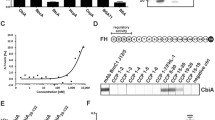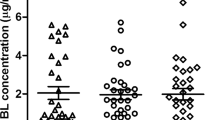Abstract
This study presents the binding of ovine factor H (fH) by various serotypes of Borrelia and simultaneously correlates their complement resistance to sheep serum. Affinity ligand binding assay was employed to study the binding of borrelial proteins to ovine recombinant fH and its truncated forms (short consensus repeat, SCR 7 and SCRs 19–20). From a repertoire of 17 borrelial strains, only two strains showed affinity to sheep fH. A ~28-kDa protein of Borrelia burgdorferi sensu stricto (B. burgdorferi s.s., strain SKT-2) bound full-length fH as well as SCRs 19–20. This fH-binding protein was further identified as complement regulator-acquiring surface protein of B. burgdorferi (BbCRASP-1) by MALDI-TOF analysis. Surprisingly, a ~26-kDa protein of Borrelia bissettii (DN127) showed affinity to full-length fH but not to SCR 7 and SCRs19–20. In complement sensitivity assay, both strains—SKT-2 and DN127—were resistant to normal sheep serum. Significant complement resistance of two Borrelia garinii strains (G117 and T25) was also observed; however, none of those strains was able to bind sheep fH. Our study underscores the need of further exploration of fH-mediated evasion of complement system by Borrelia in domestic animals.


Similar content being viewed by others
References
Bhide MR, Travnicek M, Levkutova M, Curlik J, Revajova V, Levkut M (2005) Sensitivity of Borrelia genospecies to serum complement from different animals and human: a host-pathogen relationship. FEMS Immunol Med Microbiol 43:165–172
Bhide M, Yilmaz Z, Golcu E, Torun S, Mikula I (2008) Seroprevalence of anti-Borrelia burgdorferi antibodies in dogs and horses in Turkey. Ann Agric Environ Med 15:85–90
Bhide MR, Escudero R, Camafeita E, Gil H, Jado I, Anda P (2009) Complement factor H binding by different Lyme disease and relapsing fever Borrelia in animals and human. BMC Res Notes 2:134
Chu CY, Jiang BG, Qiu EC, Zhang F, Zuo SQ, Yang H, Liu W, Cao WC (2011) Borrelia burgdorferi sensu lato in sheep keds (Melophagus ovinus), Tibet, China. Vet Microbiol 149:526–9
Ciceroni L, Simeoni J, Pacetti AI, Ciarrocchi S, Cacciapuoti B (1996) Antibodies to Borrelia burgdorferi in sheep and goats. Alto Adige-South Tyrol, Italy. New Microbiol 19:171–174
Fridriksdottir V, Nesse LL, Gudding R (1992a) Seroepidemiological studies of Borrelia burgdorferi infection in sheep in Norway. J Clin Microbiol 30:1271–1277
Fridriksdottir V, Overnes G, Stuen S (1992b) Suspected Lyme borreliosis in sheep. Vet Rec 130:323–324
Helmy N (2000) Seasonal abundance of Ornithodoros (O.) savignyi and prevalence of infection with Borrelia spirochetes in Egypt. J Egypt Soc Parasitol 30:607–619
Hovis KM, Jones JP, Sadlon T, Raval G, Gordon DL, Marconi RT (2006) Molecular analyses of the interaction of Borrelia hermsii FhbA with the complement regulatory proteins factor H and factor H-like protein 1. Infect Immun 74:2007–2014
Hovius JW, Hovius KE, Oei A, Houwers DJ, van Dam AP (2000) Antibodies against specific proteins of and immobilizing activity against three strains of Borrelia burgdorferi sensu lato can be found in symptomatic but not in infected asymptomatic dogs. J Clin Microbiol 38:2611–2621
Isogai H, Isogai E, Masuzawa T, Yanagihara Y, Matsubara M, Shimanuki M, Seta T, Fukai K, Kurosawa N, Enokidani M et al (1992) Seroepidemiological survey for antibody to Borrelia burgdorferi in cows. Microbiol Immunol 36:1029–1039
Juricova Z, Hubalek Z (2009) Serologic survey of the wild boar (Sus scrofa) for Borrelia burgdorferi sensu lato. Vector Borne Zoonotic Dis 9:479–482
Kraiczy P, Skerka C, Brade V, Zipfel PF (2001) Further characterization of complement regulator-acquiring surface proteins of Borrelia burgdorferi. Infect Immun 69:7800–7809
Kraiczy P, Hartmann K, Hellwage J, Skerka C, Kirschfink M, Brade V, Zipfel PF, Wallich R, Stevenson B (2004a) Immunological characterization of the complement regulator factor H-binding CRASP and Erp proteins of Borrelia burgdorferi. Int J Med Microbiol 293(Suppl 37):152–157
Kraiczy P, Hellwage J, Skerka C, Becker H, Kirschfink M, Simon MM, Brade V, Zipfel PF, Wallich R (2004b) Complement resistance of Borrelia burgdorferi correlates with the expression of BbCRASP-1, a novel linear plasmid-encoded surface protein that interacts with human factor H and FHL-1 and is unrelated to Erp proteins. J Biol Chem 279:2421–2429
Kurtenbach K, Sewell HS, Ogden NH, Randolph SE, Nuttall PA (1998) Serum complement sensitivity as a key factor in Lyme disease ecology. Infect Immun 66:1248–1251
Lindahl G, Sjobring U, Johnsson E (2000) Human complement regulators: a major target for pathogenic microorganisms. Curr Opin Immunol 12:44–51
Margos G, Vollmer SA, Cornet M, Garnier M, Fingerle V, Wilske B, Bormane A, Vitorino L, Collares-Pereira M, Drancourt M, Kurtenbach K (2009) A new Borrelia species defined by multilocus sequence analysis of housekeeping genes. Appl Environ Microbiol 75:5410–5416
McDowell JV, Tran E, Hamilton D, Wolfgang J, Miller K, Marconi RT (2003) Analysis of the ability of spirochete species associated with relapsing fever, avian borreliosis, and epizootic bovine abortion to bind factor H and cleave c3b. J Clin Microbiol 41:3905–3910
Ogden NH, Nuttall PA, Randolph SE (1997) Natural Lyme disease cycles maintained via sheep by co-feeding ticks. Parasitology 115(Pt 6):591–599
Picken RN, Cheng Y, Strle F, Picken MM (1996) Patient isolates of Borrelia burgdorferi sensu lato with genotypic and phenotypic similarities of strain 25015. J Infect Dis 174:1112–1115
Postic D, Ras NM, Lane RS, Hendson M, Baranton G (1998) Expanded diversity among Californian Borrelia isolates and description of Borrelia bissettii sp. nov. (formerly Borrelia group DN127). J Clin Microbiol 36:3497–3504
Ripoche J, Day AJ, Harris TJ, Sim RB (1988) The complete amino acid sequence of human complement factor H. Biochem J 249:593–602
Rodriguez de Cordoba S, Esparza-Gordillo J, Goicoechea de Jorge E, Lopez-Trascasa M, Sanchez-Corral P (2004) The human complement factor H: functional roles, genetic variations and disease associations. Mol Immunol 41:355–367
Rudenko N, Golovchenko M, Mokracek A, Piskunova N, Ruzek D, Mallatova N, Grubhoffer L (2008) Detection of Borrelia bissettii in cardiac valve tissue of a patient with endocarditis and aortic valve stenosis in the Czech Republic. J Clin Microbiol 46:3540–3543
Rudenko N, Golovchenko M, Ruzek D, Piskunova N, Mallatova N, Grubhoffer L (2009) Molecular detection of Borrelia bissettii DNA in serum samples from patients in the Czech Republic with suspected borreliosis. FEMS Microbiol Lett 292:274–281
Schneider BS, Zeidner NS, Burkot TR, Maupin GO, Piesman J (2000) Borrelia isolates in Northern Colorado identified as Borrelia bissettii. J Clin Microbiol 38:3103–3105
Strle F (1999) Lyme borreliosis in Slovenia. Zentralbl Bakteriol 289:643–652
Stuen S, Fridriksdottir V (1991) Experimental inoculation of sheep with Borrelia burgdorferi. Vet Rec 129:315
Travnicek M, Stefancikova A, Nadzamova D, Stanko M, Cislakova L, Pet'ko B, Mardzinova S, Bhide MR (2002) Seroprevalence of anti-Borrelia burgdorferi antibodies in sheep and goats from mountainous areas of Slovakia. Ann Agric Environ Med 9:153–155
Ullmann AJ, Lane RS, Kurtenbach K, Miller M, Schriefer ME, Zeldner N, Piesman J (2003) Bacteriolytic activity of selected vertebrate sera for Borrelia burgdorferi sensu stricto and Borrelia bissettii. J Parasitol 89:1256–1257
Wilske B, Preac-Mursic V, Gobel UB, Graf B, Jauris S, Soutschek E, Schwab E, Zumstein G (1993) An OspA serotyping system for Borrelia burgdorferi based on reactivity with monoclonal antibodies and OspA sequence analysis. J Clin Microbiol 31:340–350
Zarkov IS, Marinov MM (2003) The lyme disease: results of a serological study in sheep cows and dogs in Bulgaria. Rev Med Vet 154:363–366
Zipfel PF, Skerka C, Hellwage J, Jokiranta ST, Meri S, Brade V, Kraiczy P, Noris M, Remuzzi G (2002) Factor H family proteins: on complement, microbes and human diseases. Biochem Soc Trans 30:971–978
Acknowledgments
We thank Bc. Martina Cepkova for assistance in the experiments. Work was supported by research grants VEGA-1/0621/09, APVV-0036-10, and EU Structural Fund-26220120002. We thank Mr. Lee Dixon for English language editing.
Author information
Authors and Affiliations
Corresponding author
Rights and permissions
About this article
Cite this article
Kišová-Vargová, L., Čerňanská, D. & Bhide, M. Comparative study of binding of ovine complement factor H with different Borrelia genospecies. Folia Microbiol 57, 123–128 (2012). https://doi.org/10.1007/s12223-012-0104-y
Received:
Accepted:
Published:
Issue Date:
DOI: https://doi.org/10.1007/s12223-012-0104-y




